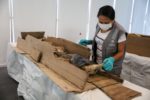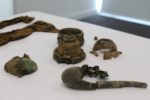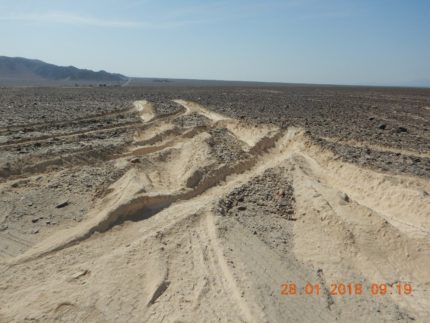 They weren’t found buried in a huaca this time. The remains of three 19th century Chinese immigrants were discovered by work crews from Calidda, a natural gas company in Lima, Peru. The bodies, buried in plain wooden coffins, were found less than a meter under the surface in Lima’s Carabayllo neighborhood where the Calidda crew was installing new pipelines.
They weren’t found buried in a huaca this time. The remains of three 19th century Chinese immigrants were discovered by work crews from Calidda, a natural gas company in Lima, Peru. The bodies, buried in plain wooden coffins, were found less than a meter under the surface in Lima’s Carabayllo neighborhood where the Calidda crew was installing new pipelines.
 Archaeologist Cecilia Camargo excavated the remains after which they were transported to her laboratory for study and conservation. She believes based on their clothing that the three individuals were adult men, but that is educated guesswork at the moment. Osteological analysis will have to be performed to confirm, and whether any conclusion can be drawn will depend on the condition of the bones. There were grave goods found inside the coffins — opium pipes and lighters, mainly — but they don’t provide much information about the people interred.
Archaeologist Cecilia Camargo excavated the remains after which they were transported to her laboratory for study and conservation. She believes based on their clothing that the three individuals were adult men, but that is educated guesswork at the moment. Osteological analysis will have to be performed to confirm, and whether any conclusion can be drawn will depend on the condition of the bones. There were grave goods found inside the coffins — opium pipes and lighters, mainly — but they don’t provide much information about the people interred.
 After the final abolition of slavery in the mid-19th century, Peru was desperate for cheap labour to work their most terrible jobs: the sugar and cotton plantations in the foothills of the Andes. Chinese immigrants stepped into the breach. They were woefully mistreated and were not allowed to be buried in municiple and church cemeteries because they were not Catholic. As a result, they were inhumed wherever a surreptitious spot could be found. Camargo thinks more such human remains will be unearthed in the Carabayllo area.
After the final abolition of slavery in the mid-19th century, Peru was desperate for cheap labour to work their most terrible jobs: the sugar and cotton plantations in the foothills of the Andes. Chinese immigrants stepped into the breach. They were woefully mistreated and were not allowed to be buried in municiple and church cemeteries because they were not Catholic. As a result, they were inhumed wherever a surreptitious spot could be found. Camargo thinks more such human remains will be unearthed in the Carabayllo area.
In other news from Peru that you probably read about elsewhere because it made headlines around the globe, the trucker who drove over the Nazca Lines, leaving tire marks on the delicate geoglyphs, has been arrested and charged with damaging an archaeological monument. There are signs warning drivers that they’re on the boundary with a forbidden zone and to keep out of the area of the Nazca Lines, signs he either deliberately ignored or didn’t see. Security personnel in the Pampas de Nazca caught him in flagrante, as it were, and reported him to the National Police of Peru. A judge released him on his own recognicance. Should he see trial and be convicted, he could receive up to six years in prison.
The good news is the damaged Lines are repairable, the Ministry of Culture’s manager in Nasca, Johny Isla Cuadrado, announced Wednesday.
“The truck left an affectation of medium grade, that is, repairable. We have people trained to restore the surface of the land and make traces of damaged geoglyphs,” Isla said in conversation with El Comercio.
The archaeologist added that the Nasca Lines have been affected for decades, including by the construction of the Panamericana Sur. “In the era of terrorism, a military camp was established in an area of geoglyphs next to the road,” Isla recalled.
Ana María Ortiz de Zevallos, head of the Decentralized Culture Directorate of Ica, said that since 2015 they have funds from the US Embassy for the conservation of the Nasca geoglyphs. With this money, figures of historical value have been repaired in recent years.
